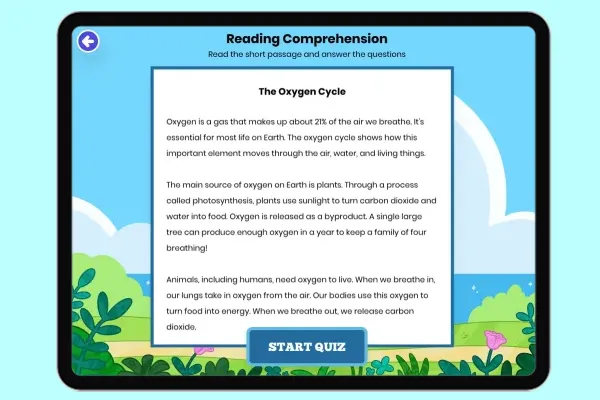Filter
RESOURCE TYPE
SUBJECT
Earth's Systems Readers and Passages
The Carbon Cycle
The carbon cycle shows how carbon travels through the atmosphere, living organisms, and the Earth. I...
RI.4.4RI.4.2
Understanding the Carbon Cycle
The carbon cycle explains how carbon moves through the environment, plants, and animals. Processes l...
RI.4.4RI.4.2
Understanding the Oxygen Cycle
The oxygen cycle explains how oxygen circulates through air, water, and living organisms. Plants pro...
RI.4.4RI.4.2
The Great Barrier Reef
This passage introduces the Great Barrier Reef, a magnificent underwater ecosystem off the coast of ...
The Water Cycle
The water cycle describes how water continuously moves through our planet via evaporation, condensat...
RI.4.4RI.4.2
The Nitrogen Cycle
The nitrogen cycle describes how nitrogen moves through the air, soil, and living organisms. It invo...
RI.4.4RI.4.2
Understanding the Phosphorus Cycle
The phosphorus cycle details how phosphorus travels through rocks, soil, water, and organisms. Essen...
RI.4.4RI.4.2
The Water Cycle: Earth's Recycling System
This educational reading passage explores the water cycle - Earth's natural system for recycling wat...
Determining Earth's Carrying Capacity
Earth's carrying capacity refers to the maximum number of people the planet can support sustainably....
The Gaia Hypothesis
The Gaia Hypothesis, proposed by James Lovelock, suggests that Earth functions like a living organis...
Measuring Carbon Stored in Vegetation
Measuring carbon stored in vegetation is crucial for understanding climate change. Plants absorb CO₂...
7.RI.7.1
Conserving Forests for Water Supply
Forests play a critical role in maintaining clean water supplies and regulating the water cycle. Con...
7.RI.7.3
Four Ways Forests Affect the Atmosphere
Forests play a vital role in regulating the atmosphere by absorbing CO₂, producing oxygen, cooling t...
7.RI.7.1
Composition of the Ocean
The ocean is made up of water, dissolved salts, gases, and organic matter. Its composition varies wi...
RI.5.3
Stream Flow
Stream flow refers to the movement of water in rivers and creeks. It is influenced by precipitation,...
RI.5.5RI.6.9
What is a Mineral?
A mineral is a naturally occurring, inorganic solid with a specific chemical composition and crystal...
RI.5.3RI.6.3RI.7.3
Difference Between a Rock and a Mineral
Rocks are mixtures of minerals, while minerals are naturally occurring, inorganic solids with a spec...
RI.5.3RI.6.3RI.7.3
Convection Currents in the Ocean
Convection currents in the ocean are driven by temperature and density differences. They play a key ...
RI.5.5
Runoff from Precipitation
Runoff from precipitation replenishes rivers and lakes but can cause flooding and pollution. Solutio...
RI.5.3RI.6.3RI.7.3
Topography of the Ocean Floor
The ocean floor features diverse landscapes like continental shelves, abyssal plains, and mid-ocean ...
RI.5.3
Porosity and Permeability of Soil and Rock
Porosity and permeability are key properties of soil and rock that affect water movement underground...
RI.5.5RI.6.9
What is Transpiration
Transpiration is the process by which plants release water vapor into the atmosphere. It cools plant...
RI.5.3RI.6.3RI.7.3
Do All Minerals Have Crystal Structures?
All minerals have a crystalline structure, but not all form visible crystals. The size and shape of ...
RI.5.3RI.6.3RI.7.3
Circulation in the Ocean
Ocean circulation involves the movement of seawater driven by wind, temperature, and salinity. It in...
RI.5.3
























